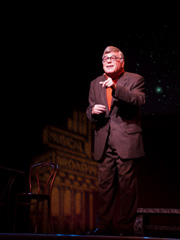
Paulanne Simmons
George Burns, Stagestruck and Lovestruck
“Say Goodnight Gracie: The Life, Laughter
and Love of George Burns and Gracie Allen” George Burns, who was born Nathan Birnbaum on January 20, 1896 and died on March 9, 1996 is known not only for his longevity, but also for his ability to sustain a career through vaudeville, radio, television and film. Much of his success was due to the uncanny comic ability of his wife and partner, Gracie Allen. So it is entirely fitting that Joel Rooks’s one-man show about the famed comedian should be called “Say Goodnight Gracie,” the line that always closed their television show and their acts. The show is subtitled “The Life, Laughter & Love of George Burns and Gracie Allen,” but Rooks begins the story way before Burns ever met Gracie, when Burns, the son of Jewish immigrants, was growing up with his many siblings on the Lower East Side. Burns’s career began after his father died and the 7-year-old discovered he had become the breadwinner of the family. While working in a candy factory, Burns figured out that singing could make the tedious job more pleasant. Not long after, he launched his career as a not very good song and dance man. When he was thirty and had “run out of things to flop at,” he met Gracie, a perfect match to his brand of “illogical logic” humor. With warmth, wit and the occasional song, Rooks takes the audience through the major stages of the Burns and Allen act. He includes stories about Burns’s lifelong friends, Jack Benny and his wife Mary, as well as other comics of the time. Nor does he leave out some of the less flattering or fortunate aspects of Burns and Allen’s life: Gracie’s inability to have children, his infidelity, her unhappy childhood. Gracie decided to quit the business in 1958 and George had to go it alone. Although Burns earned himself considerable acclaim in movies such as “Oh God!” and “The Sunshine Boys,” it’s clear that, especially after Gracie’s death, work was a poor substitute for the woman he loved. Rooks tells the story with the wisdom of an old man who has just died and is waiting to get into heaven where he will be reunited with his wife. He uses a good deal of old film and audio clips to enrich his narrative, making the show as much a journey through American entertainment history as the story of one man’s life. Many of the clips show how innovative Burns was, particularly in his tendency to break the fourth wall in both film and television. Although the story is told through the eyes of George Burns, it is Gracie who looms largest in this show, which just goes to show that behind every great man... |
| museums | NYTW mail | recordings | coupons | publications | classified |

